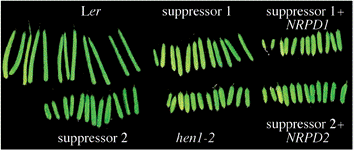Papers in the Biological Sciences

Bin Yu Publications
Document Type
Article
Date of this Version
2002
Citation
Published in Plant Physiology 129 (2002) 594-604. DOI: 10.1104/pp.002725
Abstract
Phosphatidylglycerol is a ubiquitous phospholipid that is also present in the photosynthetic membranes of plants. Multiple independent lines of evidence suggest that this lipid plays a critical role for the proper function of photosynthetic membranes and cold acclimation. In eukaryotes, different subcellular compartments are competent for the biosynthesis of phosphatidylglycerol. Details on the plant-specific pathways in different organelles are scarce. Here, we describe a phosphatidylglycerol biosynthesis-deficient mutant of Arabidopsis, pgp1. The overall content of phosphatidylglycerol is reduced by 30%. This mutant carries a point mutation in the CDP-alcohol phosphotransferase motif of the phosphatidylglycerolphosphate synthase (EC 2.7.8.5) isoform encoded by a gene on chromosome 2. The mutant shows an 80% reduction in plastidic phosphatidylglycerolphosphate synthase activity consistent with the plastidic location of this particular isoform. Mutant plants are pale green, and their photosynthesis is impaired. This mutant provides a promising new tool to elucidate the biosynthesis and function of plastidic phosphatidylglycerol in seed plants.


Comments
Copyright © 2002 American Society of Plant Biologists.